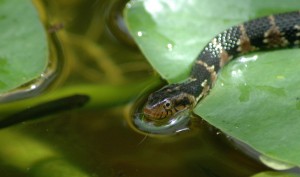One of my favorite spots to go for a walk during the week is Fern Forest Nature Center in Broward County. And on April 1 of this year, I happened to see something that I’d never seen before on the spatterdock leaves in the remnant agricultural canal that parallels the Wetland Wander trail at the park. It was a little tiny snake, not more than a foot long, if that (although I never did see it stretched out full length), resting on the broad leaves of this emergent plant. Curious, I started to take pictures.
At one point, though, this little snake’s head whipped around incredibly quickly, and it ducked underwater. Turns out, I suspect, that it was going fishing! I had never known that snakes like to go fishing. I didn’t even suspect that they might do so, despite knowing that all snakes can swim (knowledge I owe to Steve Bass, instructor extraordinaire of the Florida Master Naturalist Program here in Palm Beach County), and having seen another small snake swimming in another canal at Fern Forest.
Although I didn’t capture the actual strike on film, you can clearly see in the photo below the proximity of predator and prey, and you can fill in the gaps in the photographic record as easily as I. I only saw the snake attempt taking a fish once (and it happened far too quickly for me to photograph), but it was pretty clear what was going on.

By the way, any idea what kind of snake this is? I suspect it to be a banded watersnake, but I’m not very experienced in these matters. I tried checking them out at the Florida Museum of Natural History’s Online Guide to the Snakes of Florida, but I was never able to see the underside of the snake to determine whether these are rings or bands. I’m pretty confident they’re bands, not rings, though, given that there are only two ringed snakes in Florida: the coral snake and the king snake. I’ve also checked the photos on Daniel Dye’s website, Florida Backyard Snakes, but again, I just couldn’t find the perfect match to this critter.
Part of the problem, I suspect, is that young snakes might not look too much like adult snakes? (Obviously I’m assuming that this is a young snake; if it is in fact a banded watersnake, its size would indicate that it is young.) By far the larger part of the problem, though, is that, unlike with birds, I simply don’t see snakes very often, and so I don’t have enough personal experience to draw on.
However, at the website of the University of Georgia’s Savannah River Ecology Laboratory they’ve got photos of both color variants of this snake that I’ve seen at Fern Forest, and they’re both on the banded watersnake page, so my confidence in my identification is growing

